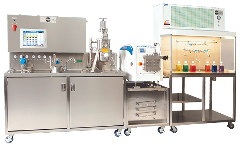“BPA poses no health risk”: EFSA
23 Jan 2015EFSA’s comprehensive re-evaluation of bisphenol A (BPA) exposure and toxicity concludes that BPA poses no health risk to consumers of any age group (including unborn children, infants and adolescents) at current exposure levels. Exposure from the diet or from a combination of sources (diet, dust, cosmetics and thermal paper) is considerably under the safe level […]

 EFSA’s comprehensive re-evaluation of bisphenol A (BPA) exposure and toxicity concludes that BPA poses no health risk to consumers of any age group (including unborn children, infants and adolescents) at current exposure levels. Exposure from the diet or from a combination of sources (diet, dust, cosmetics and thermal paper) is considerably under the safe level (the “tolerable daily intake” or TDI).
EFSA’s comprehensive re-evaluation of bisphenol A (BPA) exposure and toxicity concludes that BPA poses no health risk to consumers of any age group (including unborn children, infants and adolescents) at current exposure levels. Exposure from the diet or from a combination of sources (diet, dust, cosmetics and thermal paper) is considerably under the safe level (the “tolerable daily intake” or TDI).
Although new data and refined methodologies have led EFSA’s experts to considerably reduce the safe level of BPA from 50 micrograms per kilogram of body weight per day (µg/kg of bw/day) to 4 µg/kg of bw/day, the highest estimates for dietary exposure and for exposure from a combination of sources (called “aggregated exposure” in EFSA’s opinion) are three to five times lower than the new TDI.
Uncertainties surrounding potential health effects of BPA on the mammary gland, reproductive, metabolic, neurobehavioural and immune systems have been quantified and factored in to the calculation of the TDI. In addition, the TDI is temporary pending the outcome of a long-term study in rats, which will help to reduce these uncertainties.
BPA is a chemical compound used in the manufacture of food contact materials such as re-usable plastic tableware and can coatings (mainly protective linings). Another widespread use of BPA is in thermal paper commonly used in till/cash register receipts. Residues of BPA can migrate into food and beverages and be ingested by the consumer; BPA from other sources including thermal paper, cosmetics and dust can be absorbed through the skin and by inhalation.
Dr Trine Husøy is a member of EFSA’s expert Panel dealing with food contact materials (CEF Panel) and Chair of the BPA working group. She said: “The Panel decided to re-evaluate the safety of BPA because of the publication of a huge number of new research studies in recent years.”
To be as open and transparent as possible, EFSA thoroughly consulted and engaged with national authorities and stakeholders during this risk assessment to ensure that the widest possible range of scientific views and information were considered. According to Dr Husøy, “the public consultation process also helped us to refine our assessment through the submission of additional data and to further clarify important aspects of the opinion such as uncertainties”.
After weighing up a significant body of new scientific information on its toxic effects, the CEF Panel concluded that high doses of BPA (hundreds of times above the TDI) are likely to adversely affect the kidney and liver. It may also cause effects on the mammary gland in animals.
Studies indicating BPA as the cause of other health effects were less conclusive, stated Dr Husøy. “Effects on the reproductive, nervous, immune, metabolic and cardiovascular systems, as well as in the development of cancer are not considered likely at present but they could not be excluded on the available evidence. So, they add to the overall uncertainty about BPA-related hazards and therefore have been considered in the assessment.”
In 2006, when EFSA last assessed dietary exposure to BPA, fewer data were available and EFSA’s experts were required to make several conservative assumptions about consumption and the levels of BPA in food. “With significantly more and better data we have updated and more accurately estimated dietary exposure to BPA for all population groups, said Dr Husøy. “As a result, we now know that dietary exposure is four to fifteen times lower than previously estimated by EFSA, depending on the age group.”
For the first time, EFSA has also considered exposure to BPA from non-dietary sources. Dr Husøy underlined however: “There is a lack of supporting data on dermal exposure – for example, how much BPA the body absorbs through skin by touching thermal paper – which really increases the uncertainty of estimates from thermal paper and cosmetics”.
EFSA’s experts used new methodologies to take account of the uncertainties regarding potential health effects, exposure estimates and evaluation of risks for humans. Dr Husøy stated that “by analysing each uncertainty one by one and combining our expert judgement the Panel was able to quantify these uncertainties and to factor them in to its risk assessment and derivation of the TDI.”
EFSA will reconsider the temporary TDI when the results of long-term research by the US National Toxicology Program are available for evaluation in two to three years. This research is expected to address many of the remaining uncertainties about BPA’s toxic effects.
Related news
![Redefining brand value: Empower consumers to be resourceful and creative in the face of rising costs [Interview]](/47/pdcnewsitem/11/94/15/th119415.png)
Redefining brand value: Empower consumers to be resourceful and creative in the face of rising costs [Interview]
16 Nov 2022
With inflation, greater instability, and supply chain disruptions as a global backdrop of 2022, consumers are increasing looking for value, products with functional benefits, and convenience for the coming year, says Innova Market Insights.
Read more
MicroThermics’ Formulators Guide to Process Selection for Plant-Based Beverages
15 Nov 2022
Plant-based beverages & products are mainstream! Come to FIE booth 4D122 & read our whitepaper to see how processing in the lab at commercial HTST & UHT conditions gets you to market faster for less!
Read more![Affordability, indulgence, and health: Top trends for 2023 [Interview]](/47/pdcnewsitem/11/94/03/FiE22%20Speaker%20Interview_Alex%20Beckett2.png)
Affordability, indulgence, and health: Top trends for 2023 [Interview]
14 Nov 2022
Consumers want affordable alternatives that offer the same great taste and health benefits as their favourite products. Brands that can deliver on this will dominate in 2023, according to Mintel.In the food and beverage space, consumers are key in driv...
Read more
Give your fermented protein drinks a clear head start
10 Nov 2022
Fermented protein beverages are rising in popularity as more consumers make efforts to strengthen their health and wellbeing. Made for the ready-to-drink segment, products such as kombucha and drinking yoghurt are gaining traction as healthier alternat...
Read more![Red Bull’s ex-head of marketing shares strategies for social branding success [Interview]](/47/pdcnewsitem/11/91/47/th119147.png)
Red Bull’s ex-head of marketing shares strategies for social branding success [Interview]
21 Oct 2022
Ex-head of marketing at Red Bull Europe and current CEO of energy drink TENZING, Huib van Bockel, shares his top tips for cutting through the marketing noise and creating a socially relevant brand.
Read more
Healthy, sustainable eating shapes UK specialty product launches
14 Sep 2022
From probiotic ice cream to CBD-infused chocolate and chorizo seasoning for plant-based meat, Ingredients Network went trendspotting at the Specialty and Fine Food Fair in London.
Read more
Scouting out the latest health trends and innovations at Vitafoods Europe
20 May 2022
From mood, cognition, and gut health to the importance of selling experiences rather than products, the Healthy Marketing Team (HMT) rounds up the biggest trends it spotted at Vitafoods Europe last week.
Read more
Top trends to watch at Expo West
18 Feb 2022
From the foodification of supplements to mission-driven commerce, trendspotters at Natural Products Expo West have identified the top 10 trends shaping the US healthy food industry.
Read more
New Product Zone showcased the most innovative products at Fi Europe
15 Dec 2021
Attendees of Fi Europe 2021 were able to discover an extensive selection of the most innovative products, showcased alongside insightful information at the New Product Zone.
Read more
Startup Innovation Challenge 2021: Recognising disruptive ideas in F&B innovation
6 Dec 2021
The Fi Global Startup Innovation Challenge aims to support innovative projects within the F&B industry by offering startups the opportunity to showcase their innovations and meet the industry's foremost ingredients professionals.
Read more